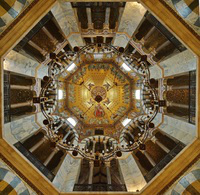Speaker
Description
Laser spectroscopy of muonic hydrogen [1,2] yielded a proton rms charge radius which is 4% (or ~6 sigmas) smaller than the CODATA value [3]. This discrepancy is now called the "proton radius puzzle" [4]. Also the deuteron charge radius from muonic deuterium [5] is 6 sigmas smaller than the CODATA value, but consistent with the smaller proton inside the deuteron.
These smaller charge radii, when combined with precision measurements of the 1S-2S transitions in regular (electronic) hydrogen [6] and deuterium [7], yield a 6 sigmas smaller value of the Rydberg constant [8], compared to the CODATA value.
In this talk I will report about a new measurement of the Rydberg constant from the 2S-4P transition in regular hydrogen performed in Garching [9], which supports the smaller, "muonic" value. Even more recently, a new measurement of the 1S-3S transition in Paris, however, confirmed the larger proton radius [10].
The situation is further complicated by new measurements in electronic and muonic helium. I will attempt to give an overview of the situation.
[1] Pohl et al. (CREMA Coll.), Nature 466, 213 (2010)
[2] Antognini et al. (CREMA Coll.), Science 339, 417 (2013)
[3] Mohr et al. (CODATA 2014), Rev. Mod. Phys. 88, 035009 (2016)
[4] Hill, EPJ Web Conf. 137. 012023 (2017)
[5] Pohl et al. (CREMA Coll.), Science 353, 669 (2016)
[6] Parthey et al., PRL 107, 203001 (2011)
[7] Parthey et al., PRL 104, 233001 (2010)
[8] Pohl et al., Metrologia 54, L1 (2017)
[9] Beyer et al., Science 358, 79 (2017)
[10] Fleurbaey et al., arxiv 1801.08816 PRL, accepted (2018)




